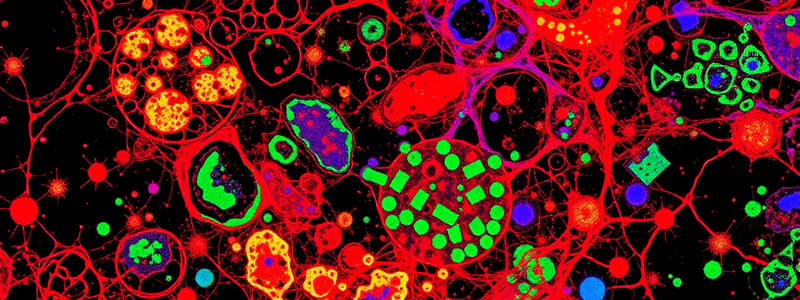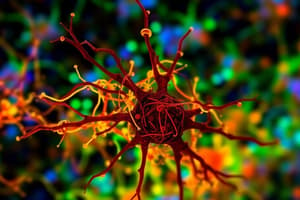Podcast
Questions and Answers
What is the purpose of denaturation in the PCR process?
What is the purpose of denaturation in the PCR process?
Denaturation separates the DNA strands by heating them to 94°C, allowing for the primers to anneal with single strands.
Why are restriction enzymes significant in genetic research?
Why are restriction enzymes significant in genetic research?
Restriction enzymes cleave DNA at specific sequences, allowing scientists to create DNA fragments for cloning, mapping, and analysis.
What differentiates rare cutters from frequent cutters among restriction enzymes?
What differentiates rare cutters from frequent cutters among restriction enzymes?
Rare cutters recognize and cut DNA at infrequent sequences, while frequent cutters cut at sequences that occur more commonly.
How are genetic maps used in genetic research?
How are genetic maps used in genetic research?
In the context of PCR, what is the role of primers during the annealing step?
In the context of PCR, what is the role of primers during the annealing step?
What information does a restriction map provide?
What information does a restriction map provide?
What is the main difference between physical maps and genetic maps?
What is the main difference between physical maps and genetic maps?
What is meant by the term 'restriction fragments'?
What is meant by the term 'restriction fragments'?
Explain the significance of using Taq polymerase in the Polymerase Chain Reaction (PCR)?
Explain the significance of using Taq polymerase in the Polymerase Chain Reaction (PCR)?
What is the purpose of the annealing stage in PCR, and at what temperature does it typically occur?
What is the purpose of the annealing stage in PCR, and at what temperature does it typically occur?
Describe how gel electrophoresis separates DNA fragments based on size.
Describe how gel electrophoresis separates DNA fragments based on size.
What is the principle behind affinity chromatography, and how does it aid in protein purification?
What is the principle behind affinity chromatography, and how does it aid in protein purification?
In the context of microscopy techniques, what is the primary advantage of using confocal fluorescence microscopy over conventional methods?
In the context of microscopy techniques, what is the primary advantage of using confocal fluorescence microscopy over conventional methods?
What role does magnesium salt play in the PCR process?
What role does magnesium salt play in the PCR process?
Explain the importance of the denaturation step in PCR, including the typical temperature used.
Explain the importance of the denaturation step in PCR, including the typical temperature used.
How does fluorescence resonance energy transfer (FRET) contribute to advancements in cellular biology research?
How does fluorescence resonance energy transfer (FRET) contribute to advancements in cellular biology research?
Flashcards are hidden until you start studying
Study Notes
Microscopy Techniques
- Brightfield microscopy is used to view unstained and stained specimens
- Phase-contrast microscopy enhances contrast in transparent specimens
- Confocal fluorescence microscopy uses lasers to illuminate specific fluorescent molecules in a sample
- Fluorescence microscopy utilizes fluorescent dyes or proteins to visualize specific structures
- Fluorescence Resonance Energy Transfer (FRET) measures the interaction between two fluorescent molecules
- Transmission Electron Microscopy (TEM) produces high-resolution images of internal cell structures
- Freeze-Fracture Replication and Freeze Etching techniques are used to study the surfaces of biological specimens
- Scanning Electron Microscopy (SEM) produces 3D images of biological specimens
- Atomic Force Microscopy (AFM) provides high-resolution images of surfaces at the nanometer scale
Fractionation Techniques
- Radioisotopes are used to label and track molecules in biological experiments
- Gel Electrophoresis separates molecules based on size and charge
- Ultracentrifugation separates molecules and organelles based on density and size
- Cell Breakage and Fractionation techniques are used to isolate specific cell components
Protein & Nucleic Acid Separation
- Density-Gradient Equilibrium Centrifugation separates molecules based on density
- Chromatography separates molecules based on their physical and chemical properties
- Gel filtration chromatography separates molecules based on size
- Affinity Chromatography uses specific ligands to bind and isolate target molecules
X-Ray Diffraction and Mass Spectrometry
- X-ray Diffraction Analysis determines the 3D structure of molecules
- Electron Microscopy (EM) and X-ray Crystallography are used to determine the structure of proteins and other biological molecules
- Mass Spectrometry identifies and quantifies molecules based on their mass-to-charge ratio
Electrophoresis and DNA Fragmentation
- Polyacrylamide Gel Electrophoresis (PAGE) separates proteins based on size
- Separation of DNA Restriction Fragments by Gel Electrophoresis identifies different DNA fragments based on size
- Two-Dimensional Gel Electrophoresis separates proteins based on both size and charge
Polymerase Chain Reaction (PCR)
- PCR amplifies specific DNA segments, allowing for sensitive detection of single DNA molecules
- Components of a PCR reaction include Taq polymerase, primers, magnesium, dNTPs, buffer, and the target DNA segment
- PCR involves three stages: denaturation, annealing, and extension
- PCR is used in diagnostics, forensics, and gene cloning
Restriction Enzymes
- Restriction endonucleases are DNA-cutting enzymes found in bacteria
- Restriction enzymes recognize specific DNA sequences called restriction sites
- They cut DNA into fragments called restriction fragments
- Restriction enzymes are classified based on their cutting behavior: rare cutters, frequent cutters, blunt-end cutters
- Restriction maps depict the locations of restriction sites along a DNA molecule
DNA Sequencing
- DNA sequencing determines the order of nucleotides in a DNA molecule
- DNA sequencing methods are used for genetic mapping, disease diagnosis, and research
Genetic Maps
- Genetic maps represent the relative locations of disease traits, physiological traits, or genes on chromosomes
- Genetic map distances are measured in centimorgans (cM)
- Markers are used to determine the distances between genes on chromosomes
Physical Maps
- Physical maps are detailed representations of DNA sequences that encompass overlapping DNA fragments
- Physical maps are constructed by analyzing cloned DNA fragments and determining their base-by-base sequence.
- Physical maps provide more detailed information than genetic maps
Studying That Suits You
Use AI to generate personalized quizzes and flashcards to suit your learning preferences.




